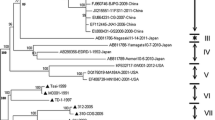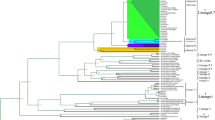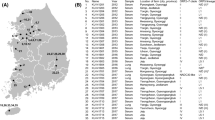Abstract
To investigate the genetic characteristics of the Korean porcine reproductive and respiratory syndrome virus (PRRSV), we determined the complete sequence of the nucleocapsid protein gene (ORF7) from 105 PRRSV isolates from all nine Korean prefectures during the years 2003 through 2006. These sequences were then analyzed along with the published ORF7 sequences for two Korean PRRS viruses (PL97-1/1997 and LMY/2002) and 36 non-Korean viruses. The ORF7 nucleotide sequence identities among the 107 Korean PRRS viruses ranged from 86.2 to 100%, corresponding to 85.4 to 100% identity at the amino acid level. All of the Korean isolates examined belonged to the North American genotype. The ORF7 gene sequence from the North American prototype virus (VR-2332) and its derived vaccine virus (Ingelvac PRRS MLV) was 90.0–100% identical to the various ORF7 sequences of the Korean isolates, with corresponding amino acid identities from 91.0 to 100%. In the phylogenetic tree obtained by neighbor-joining analysis, all of the Korean PRRSVs were divided into four groups. Our ORF7 sequence data also revealed no correlations between the date or place of collection and the distribution of PRRSV in Korea. North American genotype PRRSVs may have been introduced into Korean swine herds some time ago; these viruses apparently radiated nationwide within a relatively short period of time. Within the North American genotype PRRSVs from around the world, the Korean PRRSVs did not emerge as a single independent clade overall, and their immediate relationships with the PRRSVs from other countries could not be determined.

Similar content being viewed by others
References
Allende R, Kutish GF, Laegreid W, Lu Z, Lewis TL, Rock DL, Friesen J, Galeota JA, Doster AR, Osorio FA (2000) Mutations in the genome of porcine reproductive and respiratory syndrome virus responsible for the attenuation phenotype. Arch Virol 145:1149–1161
Cha S-H, Choi E-J, Park J-H, Yoon S-R, Song J-Y, Kwon J-H, Song H-J, Yoon K-J (2006) Molecular characterization of recent Korean porcine reproductive and respiratory syndrome (PRRS) viruses and comparison to other Asian PRRS viruses. Vet Microbiol 117:248–257
Cheon DS, Chae C (2000) Restriction fragment length polymorphism analysis of open reading frame 5 gene of porcine reproductive and respiratory syndrome virus isolates in Korea. Arch Virol 145:1481–1488
Christopher-Hennings J, Nelson EA, Nelson JK, Hines RJ, Swenson SL, Hill HT, Zimmerman JJ, Katz JB, Yaeger MJ, Chase CCL, Benfield DA (1995) Detection of porcine reproductive and respiratory syndrome virus in boar semen by PCR. J Clin Microbiol 33:1730–1734
Dea S, Gagnon CA, Mardassi H, Pirzadeh B, Rogan D (2000) Current knowledge on the structural proteins of porcine reproductive and respiratory syndrome (PRRS) virus: comparison of the North American and European isolates. Arch Virol 145:659–688
Dea S, Wilson L, Therrien D, Cornaglia E (2000) Competitive ELISA for detection of antibodies to porcine reproductive and respiratory syndrome virus using recombinant E. coli-expressed nucleocapsid protein as antigen. J Virol Methods 87:109–122
Duran JP, Climent I, Sarraseca J, Urniza A, Cortés E, Vela C, Casal JI (1997) Baculovirus expression of proteins of porcine reproductive and respiratory syndrome virus strain Olot/91. Involvement of ORF3 and ORF5 proteins in protection. Virus Genes 14:19–29
Felsenstein J (1985) Confidence limits on the phylogenies: an approach using the bootstrap. Evolution 39:783–791
Felsenstein J (1995) PHYLIP: Phylogeny Inference Package, version 3.572c. Department of Genetics. University of Washington, Seattle
Goldberg TL, Lowe JF, Milburn SM, Firkins LD (2003) Quasispecies variation of porcine reproductive and respiratory syndrome virus during natural infection. Virology 317:197–207
Hall TA (1999) BIOEDIT: a user-friendly biological sequence alignment editor and analysis program for windows 95/98/NT. Nucleic Acids Symp Ser 41:95–98
Horter DC, Pogranichniy RM, Chang CC, Richard BE, Yoon KJ, Zimmerman JJ (2002) Characterization of the carrier state in porcine reproductive and respiratory syndrome virus infection. Vet Microbiol 86:213–228
Indik S, Schmoll F, Sipos W, Klein D (2005) Genetic variability of PRRS virus in Austria: consequences for molecular diagnostic and viral quantification. Vet Microbiol 107:171–179
Inoue R, Tsukahara T, Sunaba C, Itoh M, Ushida K (2007) Simple and rapid detection of the porcine reproductive and respiratory syndrome virus from pig whole blood using filter paper. J Virol Methods 141:102–106
Kang SY, Yun SI, Park HS, Park CK, Choi HS, Lee YM (2004) Molecular characterization of PL97-1, the first Korean isolate of the porcine reproductive and respiratory syndrome virus. Virus Res 104:165–179
Keffaber K (1989) Reproductive failure of unknown etiology. Am Assoc Swine Pract Newsl 1:1–10
Kimura M (1980) A simple method for estimating evolutionary rate of base substitution through comparative studies of nucleotide sequences. J Mol Evol 16:111–120
Kumar S, Tamura K, Nei M (2004) MEGA 3: integrated software for molecular evolutionary genetics analysis and sequence alignment. Brief Bioinform 5:150–163
Kweon C-H, Kwon B-J, Lee H-J, Cho J-J, Hwang E-K, Shin J-H, Yoon Y-D, Kang Y-B, An S-H, Kim Y-H, Hu W, Jun M-H (1994) Isolation of porcine reproductive and respiratory syndrome virus (PRRSV) in Korea. Korean J Vet Res 34:77–83
Le Gall A, Legeay O, Bourhy H, Arnauld C, Albina E, Jestin A (1998) Molecular variation in the nucleoprotein gene (ORF7) of the porcine reproductive and respiratory syndrome virus (PRRSV). Virus Res 54:9–21
Madsen KG, Hansen CM, Madsen ES, Strandbygaard B, Botner A, Sorensen KJ (1998) Sequence analysis of porcine reproductive and respiratory syndrome virus of the American type collected from Danish swine herds. Arch Virol 143:1683–1700
Mateu E, Diaz I, Darwich L, Casal J, Martin M, Pujols J (2006) Evolution of ORF5 of Spanish porcine reproductive and respiratory syndrome virus strains from 1991 to 2005. Virus Res 115:198–206
Meng XJ (2000) Heterogeneity of porcine reproductive and respiratory syndrome virus: implications for current vaccine efficacy and future vaccine development. Vet Microbiol 74:309–329
Meulenberg JM (1998) Porcine reproductive and respiratory syndrome virus (PRRSV) molecular characterization of the agent. In: Proceedings of fifteenth IPVS congress, Birmingham, pp 149–157
Meulenberg JM, Hulst MM, de Meijer EJ, Moonen PL, den Besten A, de Kluyver EP, Wensvoort G, Moormann RJ (1993) Lelystad virus, the causative agent of porcine endemic abortion and respiratory syndrome (PEARS), is related to LDV and EAV. Virology 192:62–72
Murtaugh MP, Faaberg KS, Laber J, Elam MR, Kapur V (1998) Genetic variation in the PRRSV virus. Adv Exp Med Biol 440:787–794
Nei M, Gojobori T (1986) Simple method for estimating the numbers of synonymous and non synonymous nucleotide substitutions. Mol Biol Evol 3:418–428
Nielsen J, Bøtner A, Bille-Hansen V, Oleksiewicz MB, Storgaard T (2002) Experimental inoculation of late term pregnant sows with a field isolate of porcine reproductive and respiratory syndrome vaccine-derived virus. Vet Microbiol 84:1–13
Page RDM (1996) TREEVIEW: an application to display phylogenetic trees on a personal computer. Comput Appl Biosci 12:357–358
Paton DJ, Brown IH, Edwards S, Wensvoort G (1991) “Blue ear” disease of pigs. Vet Rec 128:617
Pesch S, Meyer C, Ohlinger VF (2005) New insights into the genetic diversity of European porcine reproductive and respiratory syndrome virus (PRRSV). Vet Microbiol 107:31–48
Pesente P, Rebonato V, Sandri G, Giovanardi D, Ruffoni LS, Torriani S (2006) Phylogenetic analysis of ORF5 and ORF7 sequences of porcine reproductive and respiratory syndrome virus (PRRSV) from PRRS-positive Italian farms: a showcase for PRRSV epidemiology and its consequences on farm management. Vet Microbiol 114:214–224
Saitou N, Nei M (1987) The neighbor-joining method: a new method for reconstructing phylogenetic trees. Mol Biol Evol 4:406–425
Seuberlich T, Tratschin JD, Thür B, Hofmann MA (2002) Nucleocapsid protein-based enzyme-linked immunosorbent assay for detection and differentiation of antibodies against European and North American porcine reproductive and respiratory syndrome virus. Clin Diagn Lab Immunol 9:1183–1191
Shin JH, Kang YB, Kim YJ, Yeom SH, Kweon CH, Lee WY, Jean YH, Hwang EK, Rhee JC, An SH, Cho IS, Oh JS, Joo HS, Choi CS, Molitor TW (1993) Seroepidemiological studies on porcine reproductive and respiratory syndrome in Korea. RDA J Agric Sci 35:572–576
Stadejek T, Stankevicius A, Storgaard T, Olekssiewicz MB, Belak S, Drew YW, Pejsak Z (2002) Identification of radically different variants of porcine reproductive and respiratory syndrome virus in Eastern Europe: towards a common ancestor for European and American viruses. J Gen Virol 83:1861–1873
Stadejek T, Oleksiewicz MB, Potapchuk D, Podgorska K (2006) Porcine reproductive and respiratory syndrome virus strains of exceptional diversity in eastern Europe support the definition of new genetic subtypes. J Gen Virol 87:1835–1841
Strimmer K, von Haeseler A (1996) Quartet puzzling: a quartet maximum likelihood method for reconstructing tree topologies. Mol Biol Evol 13:964–969
Thanawongnuwech R, Amonsin A, Tatsanakit A, Damrongwatanapokin S (2004) Genetics and geographical variation of porcine reproductive and respiratory syndrome virus (PRRSV) in Thailand. Vet Microbiol 101:9–21
Thompson JD, Gibson TJ, Plewniak F, Jeanmougin F, Higgins DG (1997) The Clustal-windows interface: flexible strategies for multiple sequence alignment aided by quality analysis tools. Nucleic Acids Res 22:4673–4680
Wootton S, Koljesar G., Yang L, Yoon KJ, Yoo D (2001) Antigenic importance of the carboxy-terminal beta-strand of the porcine reproductive and respiratory syndrome virus nucleocapsid protein. Clin Diagn Lab Immunol 8:598–603
Yoshii M, Kaku Y, Murakami Y, Shimizu M, Kato K, Ikeda H (2005) Genetic variation and geographic distribution of porcine reproductive and respiratory syndrome virus in Japan. Arch Virol 150:2313–2324
Zimmerman J, Benfield DA, Murtaugh MP, Osorio F, Stevenson GW, Torremorell M (2006) Porcine reproductive and respiratory syndrome virus (porcine arterivirus). In: Straw BE, Zimmerman JJ, D’Allaire S, Taylor DJ (eds) Diseases of swine, 9th edn. Blackwell, Iowa, pp 387–417
Acknowledgments
Our grateful thanks to Drs E. Mateu (Spain), G.-Z. Tong (China), and R. Thanawongunwech (Thailand) for their comments on the manuscript. This project was funded by the National Veterinary Research and Ouarantine Service (NVRQS), Ministry of Agriculture and Forestry (MAF), Republic of Korea.
Author information
Authors and Affiliations
Corresponding author
Rights and permissions
About this article
Cite this article
Yoon, S.H., Song, JY., Lee, CH. et al. Genetic characterization of the Korean porcine reproductive and respiratory syndrome viruses based on the nucleocapsid protein gene (ORF7) sequences. Arch Virol 153, 627–635 (2008). https://doi.org/10.1007/s00705-007-0027-0
Received:
Accepted:
Published:
Issue Date:
DOI: https://doi.org/10.1007/s00705-007-0027-0




